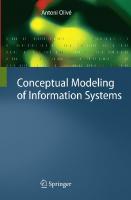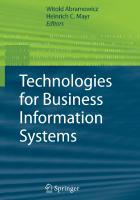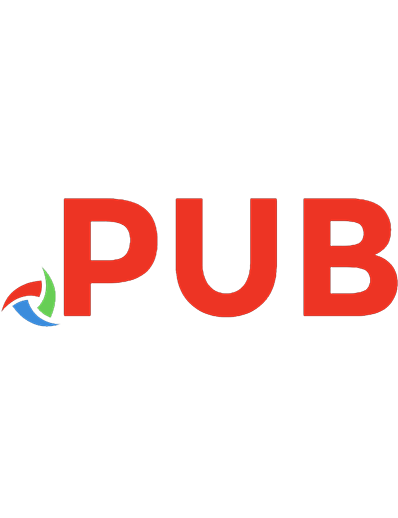Conceptual Modeling for New Information Systems Technologies 3540441220, 9783540441229
The objective of the workshops associated with ER 2001, the 20th International Con- rence on Conceptual Modeling, was to
121 83 14MB
English Pages 517 [516] Year 2002
Table of contents :
Conceptual Modeling for New Information Systems Technologies
Preface
HUMACS 2001 Workshop Organization
DASWIS 2001 Workshop Organization
eCOMO 2001 Workshop Organization
DAMA 2001 Workshop Organization
Table of Contents
Participation: The Key to Intelligent Manufacturing Improvement
Introduction
Participation and Simulation
Participative Simulation
Intellectual Capital Management in Assembly Operations
Objectives, Significance, and Benefits of PSIM
First Results from a Test
Conclusions and Recommendations
References
Challenges in Dealing with Human Factors Issues in Manufacturing Activities
Introduction
What Is Human Factors?
Topics on Human Factors in Manufacturing Activities
Human Error and Safety
Ironic Aspects of Automation
Effective Allocation of Work between Humans and Machines
Human-Centered Manufacturing Systems
Significance of Organizational Knowledge Creation
HUMACS Project and Its Significance
What Is HUMACS?
Project Outline
Significance of HUMACS
Expectation to Future Development
References
Extracting E-R Models from Collaboration Analysis Methods, MCM, and CLM
1. Introduction
2. Related Works around MCM and CLM
3. Multi-context Map
4. Collaborative Linkage Map
5. E-R Models
5.1 Entities
5.2 Relationships
5.3 E-R Diagram
6. Process of Extracting E-R Models from MCM and CLM
7. A Practical Example of the Extraction
8. Conclusion
References
Living Manufacturing Systems with Living Organizations
Introduction
Concept of System Construction – Harmonized Autonomous Decentralized Systems –
Definition of Terms
Why Autonomous Decentralized System?
Human Factors
Definition and Relationship with Manufacturing Systems
Human Factors Requirements
Example of Manufacturing Information Systems
Storage Line Control System between Painting and Assembly Processes[6]
Evaluation from the View Point of Human Factors
Human-Factors Centered Organizational Model
Conclusion
References
A Study on Human-Centric Real-Time Scheduling for PWB Assembly Line
Introduction
Visualization of Change-over Activities
The Background
Steps for Evaluation and Implementation
Evaluations of the External Change-over
IDEF0 Analysis
Process Flow by IDEF3
Simulations and Analysis of the External Change-over
Introducing of a Real-Time Scheduling System
The System Overview
Models for Real-Time Scheduling
Conclusions
References
The E/S Tool IT-Support for Ergonomic and Sociotechnical System Design
1. Introduction
2. The E/S Tool: The Combination of Ergonomics and Sociotechnics
3. The Procedure of the E/S Tool
4. The Test of the Paper and Pencil Version of the E/S Tool
5. The IT Demo Version of the E/S Tool
6. The ERGO Modules
7. The Sociotechnical Module
8. Conclusions and Next Steps
References
Construction of Virtual Working Environment and Evaluation of the Workers
1 Introduction – The Transition of Work Style –
2 Theoretical Basis
3 Method
3.1 Task Analysis
3.2 Psycho-Physiological Evaluation
4 Experiment
5 Method of Experiment
5.1 Environment of Experiment – Construction of Virtual WorkingEnvironment –
5.2 Psycho-Physiological Evaluation
6 Results
6.1 ”High Interaction and High Autonomy” Worker
6.2 “Low Interaction and High Autonomy” Worker
7 Discussion
7.1 ”Low Interaction and Low Autonomy” Worker
7.2 “High Interaction and High Autonomy” Worker
7.3 ”Low Interaction and High Autonomy” Worker
8 Conclusion – A Suggestion for Design of Work Place –
9 Further Research
References
Human Models and Data in the Ubiquitous Information Infrastructure
Introduction
From Information Islands to Ubiquitous Connectivity
Problem Sketch
Predominant Human Models
Shift of Scope for Enterprise Information Systems
Requirements for a HDMS
Consistency of Model Instances
Broad and Narrow Scoped Models
Scope Sensitive Data Management
Data Protection and Privacy
Architecture of the HDMS
Concepts
Conceptual Architecture
A Basic Human Data Management Service
Replication and the Publisher / Subscriber Pattern
Data Protection at Work
Illustration and Discussion
Illustration
Discussion
Conclusion and Future Work
References
Motion Simulation of the Human Workers for the Integrated Computer-Aided Manufacturing Process Simulation Based on Info-Ergonomics Concept
Introduction
Info-Ergonomics
Concept of Info-Ergonomics
Info-Ergonomics for Factory Workers' Motion Simulation
The Human Body/Motion Modeling Based on the ``Mediator'' Concept
Introduction of ``Mediator''
Creation of Mediator from a Hub
Info-Ergonomics Database Based on the Human Body/Motion Database
Objectives of Human Body/Motion Database
Realization of a Database of Body Shape and Motion Based on Mediator
Consideration about Flexible Query of Motion
Info-Ergonomics Simulation
Info-Ergonomics Simulation System
Concluding Remarks
References
Human-Body Motion Simulation Using Bone-Based Human Model and Construction of Motion Database
Introduction
Real World Database
Info-Ergonomics Modeling
Info-Ergonomics
The Human Body and Motion Modeling
Simulation with Precise Human Mockup
Objectives of Precise Human Modeling
Bone-Based Human Model
Modeling and Schematization of Bone-Based Human Mockup
Design and Realization of a Simulation System
Motion Data Convert System and Motion Database
Motion Simulation
Conclusion
References
Ontological Commitment for Participative Simulation
Introduction
Ontological Commitment and Knowledge-Creation
Ontological Commitments
Applying Piecemeal Ontological Commitment
Ontological Commitments for PSIM
Heraclitus’ Flow and GERAM’s Enterprise Entity Life-Cycle
Plato’s Principle of Continuant and Occurrent
Plato’s Form and CIMOSA’s Generic, Partial, and Particular Models
Peirce’s Principle of Semiotics
The Ontology Library
The Kernel Proper or a Generic Ontology
Enterprise Operations
Improvement and Renewal Procedure
Task Analysis in Ergonomy
Deploying the Ontology Library
A Simple Enterprise Ontology with Operations and Improvements
Translation Layer with Ergonomic Concepts
Ontological-Commitment-Based Navigation
Conclusion and Future Work
References
Dynamic Management Architecture for Human Oriented Production System
Introduction
Architecture of a Human Oriented Production System
Dynamic Scheduling
Considering Human Features
Case Studies
Conclusion
References
GeoCosm: A Semantics-Based Approach for Information Integration of Geospatial Data
1 Introduction
2 Motivation
3 Information Integration Approach
3.1 Metadata Management
3.1.1 Spatio-Temporal Semantic Model
3.1.2 Ontology
3.1.3 Geospatial Metadata
3.2 Query Plan Generation
4 Architecture
5 GeoCosm: A Web-Based Prototype
6 Related Work
7 Conclusions
References
Imposing Modeling Rules on Industrial Applications through Meta-modeling
1 Introduction
2 Related Work
2.1 Modeling Formalisms
2.2 Representation
3 A Meta-modeling Approach
3.1 The Modeling Problem
3.2 An Example
3.3 Mathematical Representation
3.4 Defining Consistency
3.5 Comparison to Patterns
4 Persistent Representation and Information Exchange
4.1 Schema
4.2 Document
5 Conclusion
References
Modelling Ubiquitous Web Applications – The WUML Approach
1 Introduction
2 Customisation – The Notion and the Issues
3 The WUML Approach to Customisation Design
4 Customisation Model
4.1 Context Model
4.2 Profile Model
4.3 Rule Model
4.4 Event Model
5 Customisation Notation
5.1 Notation for Specifying Customisation Hooks
5.2 Notation for Specifying Customisation Rules
5.3 Notation for Specifying Customisation Rule Patterns
6 Tool Support for Customisation
7 Outlook
References
Structuring Web Sites Using Audience Class Hierarchies
Introduction
WSDM: An Overview
Audience Classes and Subclasses
Different Subclass Hierarchies
Navigational Design
Mapping Audience Class Hierarchies into Navigation Tracks
Conclusions
References
On the Automatic Extraction of Data from the Hidden Web
Introduction
Issues in Automatic Form Filling
Related Work
Outline
Automated Form Filling
Query Submission Plan
Stratified Sampling Phase
Exhaustive Phase
Processing a Query Response Page
Filtering Duplicate Records
Conclusion
References
MIDAS/BD: A Methodological Framework for Web Database Design
Introduction
Overview of MIDAS
Web Database Design
Web Hypertext Phase
Web Database Phase
A Case of Study
Conclusions and Future Work
References
Translating XQuery into XSLT
Introduction
XQuery versus XSLT: Comparison
Overview of XQuery Translation and Execution
Preprocessing
Applying the Query
Postprocessing
XQ2XSL: Query Translation Process
Parse Tree Generation
Parse Tree Translation
Transition Rules for Selected Parse Tree Nodes
Conclusion
References
Web Site Evaluation: Methodology and Case Study
Introduction
Quality Features for Web Sites
General Analysis
Specific Analysis
A Case Study: Evaluation of the Web Sites of the Italian Government
Discussion
References
Automatic Web Information Extraction in the ROADRUNNER System
Introduction
Overview
Supervised Grammar Inference
Our Approach
The Wrapper Generation Algorithm
The ROADRUNNER
System Architecture
The Aligner
The Classifier
The Expander
The Labeler
References
Querying Relational Databases without Explicit Joins*
Introduction
Semantic Capture Process
Global Dictionary Definition
Semantic Names
X-Specs
Semantic View Construction
Query Processing
Enumerating Semantic Names
Attribute and Relation Selection
Determining Join Conditions
Graphically Guiding the User during Query Generation
Generation and Execution of SQL Queries
Related Work
Future Work and Conclusions
References
NF-SS: A Normal Form for Semistructured Schema
1. Introduction
2. Motivating Example
3. A Normal Form for Semistructured Schema (NF-SS)
3.1 Semistructured Schema (D) and Data Tree (T)
3.2 Extended Functional Dependency (EFD) and Key Constraints
Extended Functional Dependency (EFD)
Key Constraints
3.3 NF-SS: Normal Form for Semistructured Schemata
4. Designing Semistructured Schema in NF-SS
4.1 Normalization Rules
4.2 Restructuring Algorithm
4.3 Discussion
5. Related Works
6. Conclusion
References
A Formal Analysis of the Lightweight Directory Access Protocol
Introduction
LDAP Directory Model
General Model
Logical Framework
Containment of LDAP Queries
Schema Integrity Constraints in LDAP
Related Work
Conclusion
References
An XML Document Retrieval System Supporting Structure- and Content-Based Queries
Introduction
Related Work
Structure-and Content-Based XML Document Retrieval System
Indexing Based on Document Structure
Indexing Based on Image Content
Low-Level Storage Manager
Keyword Index Structure
Structure Index Structure
Index Structure for Content-Based Retrieval
Unified Retrieval
User Interface
Implementation and Performance Analysis
Conclusions
References
Extraction of Partial XML Documents Using IR-Based Structure and Contents Analysis
Introduction
Related Work
XPath Data Model
Identification of Candidate XML Contextual Partial Documents
Manual Analysis of DTDs
Automatic Identification of Context Nodes
Experimental Evaluation of Partial Document Extraction in the Vector Space Model
Our Retrieval System Setup
Reference Collection
Preliminary Experimental Results
Conclusion
References
XDoC-WFMS: A Framework for Document Centric Workflow Management System
Introduction
Contributions and Organization of the Paper
Concepts, Terminology, and Specification
Architecture of XDoC-WFMS
Example
Execution Model
Architecture of Workflow Coordinator
The Workflow Execution Algorithm
Discussion
Related Work
Conclusion
References
Active XML Schemas
1 Introduction
2 Active Extension of XML Schema
2.1 Passive Behavior
2.2 Event Types and Event Classes
2.3 Import and Export of Event Classes
2.4 Rules
3 Advanced Concepts
3.1 Event Timestamps
3.2 Scheduling Events
3.3 Logical Events
3.4 Exception Rules
4 Managing Active XML Schemas
4.1 Reactive Service
4.2 Communication Transparency
4.3 Event Source Transparency
References
Behavior Abstraction in Semantic B2B Integration
1 Introduction
2 Requirements for a Public Process Model
2.1 Message Types
2.2 Message Patterns
2.3 Public Processes
2.4 Control Flow in Public Processes
2.5 Order Preservation, Correlation, and Duplicate Detection
3 Advanced Model for Public Processes
3.1 Messages
3.2 Activities
3.3 Control Flow
3.4 Data Flow
3.5 Execution Model
4 Related Work
References
OIL Ontologies for Collaborative Task Performance in Coalitions of Self-Interested Actors
1 Introduction
2 Related Work
3 Motivating Example
4 Task Model
5 Arrangement Phase
6 Task and Negotiation Ontologies
7 Conclusions and Future Work
References
A Multi-perspective Methodology for Modelling Inter-enterprise Business Processes
Introduction
The Methodology of Agent-Oriented Modelling
The Modelling Process
Analysis of the Problem Domain by i*
Design by Agent-Object-Relationship Modelling
Related Work
Conclusions and Future Work
References
Process Patterns to Generate E-commerce Systems
1 Introduction
2 Related Research and Conceptual Framework
3 Generic Process Patterns
3.1 Economic Resource Requesting Diagram (ERRD)
3.2 Economic Resource Offering Diagram (EROD)
3.3 Providability Checking Diagram (PCD)
3.4 Counter Offer Diagram (COD)
3.5. Process Model
4 A Designer Assistant
4.1 Phase 1 - Business Model
4.2 Phase 2 - Economic Event Order (EEO)
4.2.1 Reservation and Booking
4.3 Phase 3 - Process Order
4.4 Phase 4 - Mapping Process Order to BML Process Model
Concluding Remarks
References
Formalising Feasibility and Correctness of Distributed Business Processes
Introduction
Modelling Products
Descriptive Production Modelling
Production Cell
Production Operations
Production Operations: Feasibility
Production Operations: Execution
Production Operations: Concurrency
Production Processes
Prescriptive Production Modelling
Relating Descriptive and Prescriptive Models
Conclusions
References
Modeling Products for Versatile E-commerce Platforms – Essential Requirements and Generic Design Alternatives
Introduction
Requirements and State of the Art Solutions
Levels of Abstraction
Instantiation, Specialization, and Re-use
Layers in Common Software Architectures
Three Prototypical Design Alternatives
Emphasis on Versatile Definitions of Product Types and Configurations
Emphasis on Re-use
Compromising Flexibility for Re-usability: A Pragmatic Approach
Conclusions and Future Work
References
Seamless Personalization of E-commerce Applications
1 Introduction
2 Our View of E-commerce Applications
3 Modeling and Design of Personalized Applications
4 An Example
5 Separating Personalization Concerns
5.1 Personalizer Wrappers
5.2 Rule Objects
5.3 Dealing with Evolving User Profiles
5.4 Putting All Pieces Together
6 Conclusions and Further Work
References
Discovery of User Preference through Genetic Algorithm and Bayesian Categorization for Recommendation
1 Introduction
2 System Overview
3 Content Based Filtering
3.1 Feature Selection
3.2 Categorizing Item Using Naïve Bayes Classifier
4 Collaborative Filtering
4.1 Optimal User Clustering
4.2 Generating Group Profile
4.3 Discovery of User Preference
5 Evaluation
6 Conclusions
References
Using the Quantum Data Model to Develop Shareable Definitions
Introduction
Technical Development Driven by Necessity
What Is the Quantum Data Model?
What Is New about It?
Why Was This Development Necessary?
Key Features of CBML
Characteristics
History, Projection, and Competing Versions
Complex Characteristics
Categorisation
Entity Class Sets
Designation Scheme
Comparison with Other Languages
Why Not Use ER?
Why Not Use UML ?
Why Not Use ORM ?
Why Is CBML Better ?
Data Standardisation in a Large Enterprise
Legacy Models
CBML Models
Case Study
Development of Conceptual Schema for a Business Area
Development of Conceptual Schema for a Legacy System
Enterprise Model
Conclusion
References
Author Index





![Information Systems and Technologies: WorldCIST 2023 [2]
3031456440, 9783031456442](https://dokumen.pub/img/200x200/information-systems-and-technologies-worldcist-2023-2-3031456440-9783031456442.jpg)



